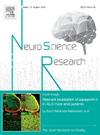偏置丘脑神经支配到多巴胺受体1在尾状体中主要表达的独特亚区。
IF 2.4
4区 医学
Q3 NEUROSCIENCES
引用次数: 0
摘要
在尾侧纹状体腹侧,直接和间接通路神经元分布不均匀,形成多巴胺受体1 (D1R)或多巴胺受体2 (D2R)神经元缺乏的区域,称为D1R-或D2R-贫区(分别为D1pz或D2pz)。这与它们在其他纹状体区域的均匀分布形成对比。一个关键问题是D1pz和D2pz是作为一个整体还是独立发挥作用。由于纹状体需要传入兴奋输入来激活,因此研究尾侧纹状体的偏向性兴奋输入是必要的。我们的研究结果表明,水疱性谷氨酸转运蛋白2 (VGluT2)集中在D2pz,提示偏向性兴奋神经支配。逆行示踪标记确定了皮层下谷氨酸能投射的潜在来源。使用VGluT2-Cre小鼠观察丘脑室旁核(PVT)的投影。PVT优先投射到纹状体尾侧腹侧区。定量分析显示PVT轴突优先定位于D2pz,而D1pz轴突较少。由尾状纹状体支配的黑质外侧部没有投射到PVT,这表明尾状纹状体和PVT可能不是皮质-基底神经节-丘脑回路的一部分。这些结果表明,D1pz和D2pz可能被PVT输入不同地激活,选择性地招募直接通路。本文章由计算机程序翻译,如有差异,请以英文原文为准。
Biased thalamic innervation onto the distinct subregion where dopamine receptor 1 is dominantly expressed in the caudal striatum
In the ventral part of the caudal striatum, the direct and indirect pathway neurons are unevenly distributed, forming zones with a paucity of neurons with dopamine receptor 1 (D1R) or dopamine receptor 2 (D2R), referred as D1R- or D2R-poor zone (D1pz or D2pz, respectively). This contrasts with their uniform distribution in other striatal regions. A key question is whether D1pz and D2pz function as a unit or independently. Since the striatum requires afferent excitatory inputs for activation, investigating biased excitatory inputs to the caudal striatum is essential. Our findings indicate that vesicular glutamate transporter 2 (VGluT2) was concentrated in D2pz, suggesting biased excitatory innervation. Retrograde tracer labeling identified potential sources of subcortical glutamatergic projections. Projection from the paraventricular nucleus of the thalamus (PVT) was visualized using VGluT2-Cre mice. PVT preferentially projected to the ventral caudal region in the striatum. Quantitative analysis of PVT axons revealed preferential localization in the D2pz, with fewer axons in the D1pz. The substantia nigra pars lateralis, innervated by the caudal striatum, did not project to the PVT, suggesting the caudal striatum and PVT may not form a part of the cortico-basal ganglia-thalamic loop. These results imply that D1pz and D2pz may be differentially activated by PVT inputs, selectively recruiting direct pathways.
求助全文
通过发布文献求助,成功后即可免费获取论文全文。
去求助
来源期刊

Neuroscience Research
医学-神经科学
CiteScore
5.60
自引率
3.40%
发文量
136
审稿时长
28 days
期刊介绍:
The international journal publishing original full-length research articles, short communications, technical notes, and reviews on all aspects of neuroscience
Neuroscience Research is an international journal for high quality articles in all branches of neuroscience, from the molecular to the behavioral levels. The journal is published in collaboration with the Japan Neuroscience Society and is open to all contributors in the world.
 求助内容:
求助内容: 应助结果提醒方式:
应助结果提醒方式:


